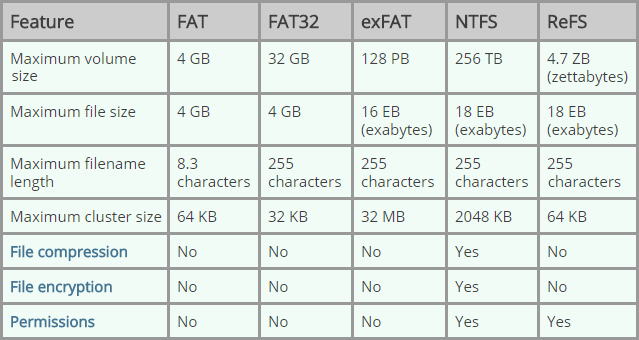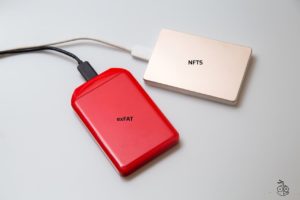

It was adopted by the SD card association for the default file system of cards greater than 32GB. The extended File Allocation Table system or exFAT was designed by Microsoft and introduced in 2006.
#Exfat vs ntfs windows#
FAT32 is no longer used on modern, internal Windows hard drives as most systems have adopted the NTFS standard.The theoretical limit for the same is 16TB. It is possible to expand it up to 2TB using 3rd party tools. The native disk’s maximum disk size for FAT32 is 32 GB.No control over file permissions and data security.Each file in a FAT32 drive can have a maximum size of 4GB (GigaBytes).It’s also the defacto standard for many USB flash drives and even some types of external hard drives.FAT32 is the official format for SD and SDHC cards.In FAT32 file systems the drive sizes between 2 and 16 TB with 64KB clusters.The backup FAT table copy gets automatically relocated to the root folder in FAT32 systems, which further can be used for the restoration of files.A FAT32 file system can hold up to 268,173,300 files, provided it is using 32KB clusters.Being one of the oldest file systems, it has some profound limitations.īut there are also some advantages of using a FAT32.
#Exfat vs ntfs android#
FAT32 is almost universally understood not only by PCs running Windows but also Linux, macOS, cameras, media players, game consoles, smart TVs, Android phones, and so on. There have been several variations of FAT, based on the size of the table as it’s a file allocation table that holds information about the files like FAT8, FAT12, and FAT16. It was originally developed for floppy disks however over the years it found its way onto the hard drive, USB flash drives, and SSD cards, and it was the default file system for windows up until Windows XP. It was first introduced on MS-DOS 7.1 / Windows 95 OSR2 in 1996 replacing the previous FAT16 file system. In this article, we will look into the key difference between them.įAT32 or the File Allocation Table file system is one of the oldest file systems available on the Windows machine. In addition to that, there might be other things like folders and file permissions, etc. It needs to have a way to associate a file name with that file’s contents. There are 3 types of the file system in a device:Īs mentioned earlier when you store a file on a disk, the operating system needs to know where the file is physically located. In simpler words, we can say that the file system controls the flow of storage and retrieval of data in a device. It needs to be organized and that organization is called a file system.Ī File System is a collection of rules and algorithms that is responsible for translating logical file operations to the physical storage of information. You can’t just write it randomly on a drive and then expect to get it back one day when you need it. When you write data to a storage medium whether it’s a hard drive or an SSD or an SD card or a micro SD card or a USB flash drive you need to write the data in such a way that it can be found again.

#Exfat vs ntfs free#

Difference between Spooling and Buffering.Difference between FAT32, exFAT, and NTFS File System.ISRO CS Syllabus for Scientist/Engineer Exam.ISRO CS Original Papers and Official Keys.GATE CS Original Papers and Official Keys.


 0 kommentar(er)
0 kommentar(er)
